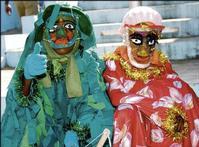Keisha Shakespeare, Staff Reporter

Participants in the children's Jonkonnu costume competition held at the Louise Bennett Garden Theatre On December 10. - ANDREW SMITH/PHOTOGRAPHY EDITOR
CHRISTMAS DAY there are scenes of people busily white-washing their fences, tree trunks and stones, using white lime. The houses are well painted and citizens who cannot afford a tin of paint use the white lime which looks just as good.
Members of the community join together in a massive beautification drive by cleaning the sidewalks, gullies, and drains. Men and boys clean up the yard and sidewalks; the women and girls stay home to keep house. It is like a colossal spring-cleaning exercise and when they are finished, the houses are spic and span.
In the rural areas, most people use Christmas cards that they received in previous years to decorate their homes.
Also by mid, December, a big Christmas tree stands tall in the community's square with beaming lights shining brightly spreading the Christmas cheer. The tailors and dressmakers have their hands full as they hastily try to complete the season's outfits. The hairdressers and barbers are not to be outdone as their shops are jam-packed with people getting their dos. In every town, the crowd is thick as everyone goes about doing his or her last-minute Christmas shopping. Supermarkets and markets are usually filled to capacity with shoppers buying goodies for the holidays.
On Christmas Eve, grand-market activities come alive. This is the time all the children have a chance to go to the nearest town with their parents to shop. Some children usually save their money to purchase what they like. In every house you visit, the aroma of sorrel and cakes being baked fill the air. This is a night no child sleeps as they are too busy playing in the streets with firecrackers and starlights.
Jonkunnu
A major part of Jamaican Christmas tradition also is Jokonnu (John Canoe). Jokonnu is a band of masqueraders that appears in some towns and villages at Christmas time. The custom of Jonkunnu dates from the days of slavery. Over the years the custom has died out and Jonkunnu today is but a shadow of its former self.
Jonkunnu bands today may include a mixture of traditional and more contemporary characters: Cow Head or Horse Head, King and Queen (wearing a veil), a Devil, Pitchy-Patchy, Belly Woman and Feathers, a policeman to keep the crowd in check. The band is usually accompanied by musicians.
Children scared
Mrs. Pearline Smith, a retired postmistresses told Lifestyle she remembers that as child growing up in St. Mary, the Jonkunnu band used to start practising from as early as September. And on Christmas Day they marched from town to town dancing and playing drums and the drums could be heard from a mile away.
She added that she used to be very scared of and ran away when they drew near. She reminisced that she was most scared of horse head and the devil because they were too ugly. She also noted that all the other children ran away too. And the only ones who stood to watch were the ones who their parents forced to do so.
All the characters in the band were played by men who wore masks. If the characters spoke at all, it would be in hoarse whispers - part of the tradition that their identity should not be known. Those who watched their antics were expected to contribute money to the band to help defray the expenses of their costumes or to provide refreshment to keep up their energy.
Used for Research
The jonkunnu band is one aspect of Jamaican culture that has provided a rich field for researchers. The word jonkunnu originated from similar sounding words spoken in the Ewe language (of eastern Ghana and Tobago), dzono (sorcerer) and kunu (deadly). The sounds related meanings of the words reinforce the hypothesis of recent scholars that jonkunnu practices forms and structures, examples: music, dance, characters, masquerade, secrecy, probably had their origins in West African secret societies. Thus the earliest masquerades in Jamaica were associated with fear and secrecy.
Jonkunnu reached its peak during the plantation era, when European slave masters actively encouraged it by promoting the festivities on their estates. However, by emancipation in 1838 the jonkunnu band declined as the churches combined to stamp out pagan amusements and rituals. Also currently the band mostly performs at culture festivals and functions.
Carolling
Another Christmas-time Jamaican tradition is carolling. Vivian Crawford, executive director of the Institute of Jamaica in Kingston said he remembers that people visited hospitals to sing carols. They went to spread the Christmas cheer to the patients who were unable to go out.
"Also I remember as child growing up in Moore Town in Portland the children had to bring things to the older people in the community. We had to bring them firewood and fetch water for them," said Mr. Crawford.
He chuckled as he reminisced on the good old Christmas days in his community. He told Lifestyle that in his community they blew the Abeng (made from cow's horn) to communicate. He added that at 2:00 a.m. on Christmas morning when the first bus or truck pulled in the town (Port Antonio), the abeng was blown to signify that Christmas had begun.
Mr. Crawford noted that back then Christmas was all about caring. And all the children visited their godparents and received gifts. Also Christmas was the time of year everyone got new clothes and could drink any amount of aerated water (soda) they wanted.
Carolling in other parts of the island differs from one community to the next. In Milk River, Clarendon local church members go out carolling in the wee hours on Christmas morning. With candles lit they go from district to district singing songs of Jesus? birth. Usually carolling is followed by a short service in the church then everyone is wished a merry Christmas asthey head to their separate ways.

